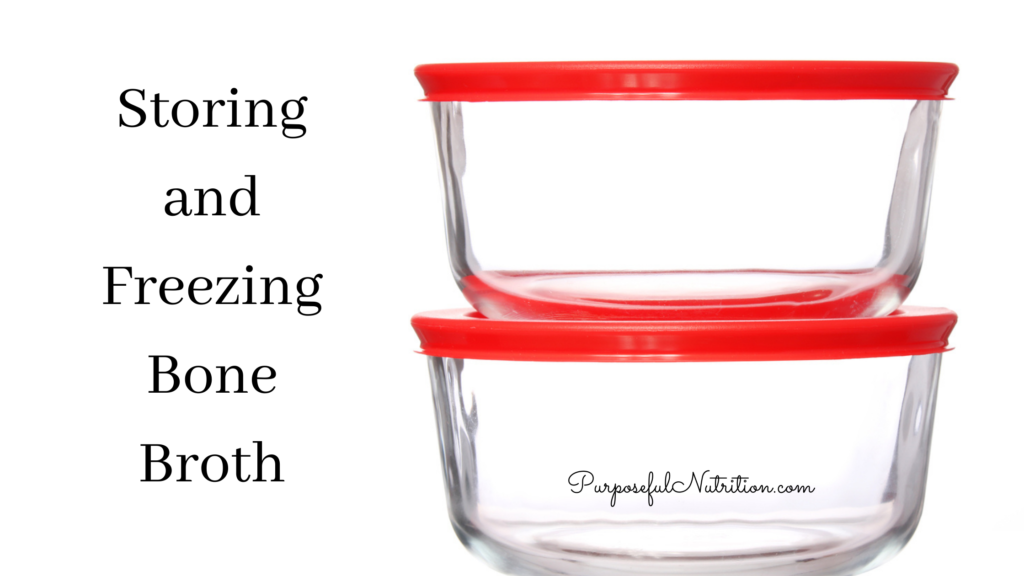This post may contain affiliate links which won’t change your price but will share some commission.
Do you remember that first little batch of bone broth you made? Chances are that it was gone before it had time to cool all the way down. Since then you’ve invested in a much larger stock pot and you’re buying soup and knuckle bones by the pounds. The end result is a lot more broth then you can use up right away. Making big batches is a lot easier and more efficient. Now let’s find out how to store everything you can’t use up right away.
Storing Bone Broth In The Fridge
Allow your bone broth to cool completely after you’ve finished boiling it. Anything you haven’t used up by this point should be strained into clean jars and stored in the fridge for up to a week.
You can use the broth straight from the fridge in your favorite soups or stews. If you want a cup to drink, pour some in a small pot and warm over the stove. Add a few herbs and spices to taste. This will come in particularly handy after the broth has set for a few day and doesn’t taste quite as good as the first day.
Freezing Bone Broth For Long Term Storage
If you have more broth than you can use over the course of a few days, it’s probably a good idea to go ahead and freeze the majority of it. Once your pot of broth and bones has cooled enough to be safe to handle, strain the liquid into a large bowl or pitcher.
Depending on how you plan to use the broth later on, you can either freeze it in glass jars or plastic containers, or pour it into ice cube trays for smaller portions of broths that you can add to veggies as you cook them, think out mashed potatoes etc. Or use a combination of both.
Get your freezer containers ready and stir up your broth to make sure all the nutrients are equally distributed. Pour the broth in the freezer containers and allow them to stay on the counter until they have cooled down to room temperature.
Label your containers with the contents and today’s date and move them to the freezer. When using ice cube trays, set them in the freezer for a few hours or until the broth is frozen solid, then pop them out and transfer them to a freezer bag. Label the bag and put it back in the freezer. You can grab individual bone broth cubes as you need them.
Canning Bone Broth for Long Term Storage
If freezer space is a challenge, there is canning bone broth. In order to can broth, it must be pressure canned. Water bath canning will not safely work with broth. So it is important to borrow or buy a pressure canner if you wish to do this.
After making the broth, it is important to put hot broth into hot jars, leaving an 1 inch headspace. Process at 10 pounds pressure, pints 20 minutes and quarts for 25 minutes. (This is for those below 1000 ft altitude.)
You can also make soup with the broth and can it as prepared soup, if you want to make some easier meals to have on hand.
Dehydrating Bone Broth
One more option that may not occur to most people is dehydrating bone broth. This will give you something like homemade bouillion, but without all the salt and other preservatives in most of what you buy.
Start with your liquid broth and then cook it at a simmer until it is very concentrated. Then carefully pour the broth onto dehydrator sheets.
- Start with liquid broth. You can use beef, chicken, fish, or vegetable broth.
- Bring it to a boil, then turn the heat down to a simmer to keep the water boiling off. This process took about 6 hours to do for me.
- Carefully pour the broth on to the dehydrator sheets.
- Place in the dehydrator at 135°-140°. This is the longest part of the whole process.
- After 24-48 hours, you should be able to lift the broth off the sheet all in one piece.
- Flip this over and place back in the dehydrator for another 24-48 hours.
- When your broth looks clearish, and is easily breakable, it’s done.
So what method have you found works best for you for storing your broth?


Leave a Reply